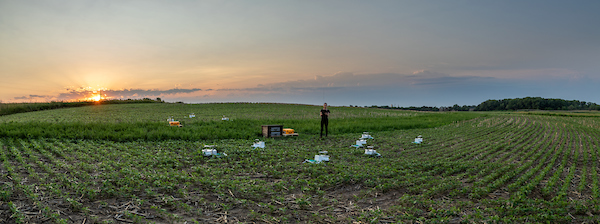
|

November NEWSLETTER
Highlights in this month’s Newsline:
- Customize your long-term or survey soil system to get precise soil gas flux measurements in real time
- Expand your long-term soil research with the NEW 8250-01 Extension Manifold
- Register for our Dynamic Assimilation™ Technique seminar with Michigan State
- Missed the webinar on complementary measurements with the LI-600 and LI-6800? You can still get all the info
- Sign up for an international webinar series on evapotranspiration principles and methods
- Assessing terrestrial ecosystems’ responses to environmental and climate changes and biodiversity loss
|
A complete soil gas flux system built to fit your research needs
|
New solutions from LI-COR make it easier than ever to measure greenhouse gas emissions from soils. Now, you can incorporate multiple trace gas analyzers to get fast, high-quality measurements of nearly any gas. With our precise instruments and advanced software, depend on real-time data from a survey or long-term soil gas flux monitoring system and analyze your measurements as they are completed. Design your own system with our online tool to mix and match the analyzer you need with up to 36 chambers.
Design your System |
| |
|
What could you measure with 36 chambers?
Introducing the NEW 8250-01 Extension Manifold
|
Your long-term soil gas flux research site can now include dozens of chambers distributed over a 2800 square meter footprint—more than 1/4 of a hectare—with the NEW 8250-01 Extension Manifold.
|
Powered by the LI-8250 Multiplexer, each Extension Manifold allows multiple chambers or flasks to share a single LI-8250 port. By extending the maximum number of field site chambers from 8 up to 36, you can ask new research questions and have more confidence in the answers.
|
| Expand your research |
|
Upcoming Seminar:
Using Dynamic Assimilation™ Technique to study leaf biochemistry and the timeline of phosphate limitation
Join graduate research assistant Alan McClain of the MSU-DOE Plant Research Laboratory at Michigan State University as he describes state-of-the art research investigating the physiological control of photosynthesis at time scales ranging from instantaneous up to 30 hours. At the November 17 seminar, hosted by LI-COR, learn how his research, which used the Dynamic Assimilation™ Technique, reveals new insights into the biochemistry of leaves with an emphasis on the timeline of phosphate limitation.
|
|
Wednesday, November 17
10:00 AM CST
|
|
Speaker:
Alan McClain,
Michigan State University
|
|
Register Now
|
|
Record larger, more informative data sets with the LI-600 and LI-6800
Interested in recording larger, more informative data sets while saving time? You can combine fast survey measurements from the LI-600 Porometer/Fluorometer with detailed data from the LI-6800 Portable Photosynthesis System. To learn how, view our webinar, “Complementary measurements with the LI-600 and LI-6800.” In the recording, Jason Hupp, Sr. Field Application Scientist, describes complementary applications of the two instruments and summarizes two case studies that highlight the benefits of pairing the LI-600 with the LI-6800.
Watch the video
|
|
Attend an international webinar series with evapotranspiration experts
Explore evapotranspiration principles and measurement methods with international and regional experts in a bi-weekly webinar series hosted by ICARDA and the Food and Agriculture Organization of the United Nations. Each session from 1500 to 1730 (GMT+2) will feature a one-hour talk followed by a 30-minute Q&A session. The November 10 presentation will feature Dr. Christopher Neale of the University of Nebraska-Lincoln and Dr. George Burba, Science and Strategy Fellow at LI-COR, with a seminar titled “ET Flux Networking: Latest Tools for Connecting Flux, Remote Sensing and Modelling Communities via Time- and Space-Synchronized Datasets.” Register through the ICARDA website for the webinar series.
Sign up for the webinar
|
|
Defining the major axes of terrestrial ecosystem functions
Authors of a study recently published in Nature describe three key axes of major terrestrial ecosystem functions: maximum productivity, water-use strategies, and carbon-use efficiency. Their approach provides a method for measuring the overall function of land-based ecosystems, which they uncovered as crucial for assessing the ecosystems’ responses to environmental and climate changes as well as loss of biodiversity. The group used data collected with LI-COR eddy covariance instruments and systems that measured CO2and H2O exchange between ecosystems and the atmosphere. Check out the publication to see the eddy covariance data.
Read the paper
Eddy covariance Photosynthesis
|
Trainings
|
|
Photosynthesis Training
9-10 November 2021
Online - Europe
16‑17 November 2021
Online - USA
7‑9 December 2021
Lincoln, Nebraska, USA
Register for photosynthesis training
Eddy Covariance Training
18-19 January 2022
Lincoln, Nebraska, USA
Register for eddy covariance training
|
| |